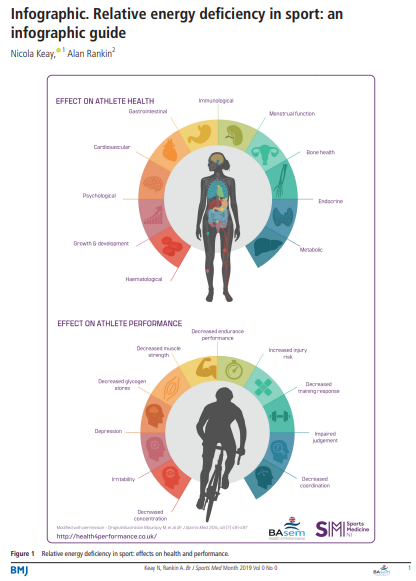RED-S: Is it the reason for your athlete’s struggles?
I know I’m talking a lot about underfueling lately. But, with what I know and all I’ve seen in the last couple of years, I feel like I would be doing my followers, clients and athletes a true disservice if I glossed over the topic or, worse, didn’t address it at all.
So, today I’m going to spend time giving you a surface-level overview on a relatively new medical condition known as Relative Energy Deficiency in Sport, also known as RED-S.
I talk about this condition ALL THE TIME whether I’m in clinic or speaking in schools or speaking at a conference. I can speak in depth on this topic for 30 to 45 minutes if given the time but this post is just to give you an introduction to this important-to-know-about condition so it will be much more brief. So, today I hope to hit the high points on this important condition called RED-S.
BEFORE THERE WAS RED-S
Researchers have been studying underfueling, or as I explained in my last post, Low Energy Availability (LEA), for a long time.
Lea in Females
Initially this occurrence of LEA was associated with females in what was termed the Female Athlete Triad. The Female Athlete Triad is a medical condition in which a female athlete experiences one of the following:
Compromised bone health
Irregular menstrual cycle
Underfueling (intentional or unintentional)
lea in Males
As researchers and clinicians continued to look into underfueling and its effects on athletes, their health and their performance they found that a similar condition to the Female Athlete Triad with similar consequences could present itself in males as well. And so a condition in male athletes was established called the Male Athlete Triad.
In males the condition could manifest in several ways, very similar to females:
Compromised bone health
Altered hormone levels and cycles (testosterone levels, etc.)
Underfueling (intentional or unintentional)
In both Female Athlete & Male Athlete Triad…
Not all components have to be present to be diagnosed by a physician. It might be that the athlete only exhibits one. However, if one component is present, it is very likely that others are present as well and so further examination into the others is recommended. From my practice, I see that the root cause is the underfueling. And from there, if not noticed and managed leads to what we see and the athlete experiences - the bone injuries and / or the hormone changes. lost periods, etc.
In practice…
I typically come in when a female athlete has:
lost her period for 3 months or more or
has experienced one or more stress fractures or
when an athlete has exhibited some significant weight loss or a weight plateau in the last few months to years, causing her to start falling off her growth chart.
I’ve found that for some female athletes it takes a small amount of underfueling and for others it takes extreme underfueling for their menstrual cycle to be disrupted. But, just because a female athlete still has her period, it does not mean she is for sure fueling enough and appropriately. Just something to keep in mind.
I typically come in when male athletes have:
had one or more stress injuries in the last year
had altered labs at their last pediatrician visit or
H=had recent weight loss or a weight plateau, causing them to start falling off their growth chart.
DISCOVERING RED-S
Researchers and clinicians were aware of the Female and Male Athlete Triad but continued to study the effects of underfueling and LEA (and we’re still studying LEA today).
the effects of underfueling and LEA can reach beyond decreased bone health, hormone regulation, and menstrual dysfunction
As they studied athletes and underfueling they started to see that the effects of underfueling and LEA can reach beyond decreased bone health, hormone regulation, and menstrual dysfunction. It can actually have a much wider scope of impact on the athlete’s health and performance. Underfueling can impact an athlete’s:
mental health (seen or felt as increased anxiety for example),
cardiovascular health (ex: slowed heart rate as the body tries to preserve energy)
metabolism
gastrointestinal health
immune system
endocrine system
haematological (iron deficiency anyone?)
growth & development
DETECTING RED-S
Putting this into practice, some examples of when I would look further into RED-S and check an athlete’s fueling would be:
A typical non-anxious athlete begins to struggle with anxiety.
An athlete already diagnosed with anxiety has been feeling heightened anxiety lately.
The pediatrician or other medical professional has observed a very low heart rate.
The athlete has started complaining of GI issues like constipation or feeling like it takes a long time to digest food. Maybe they just don’t get hungry anymore.
The athlete is constantly getting sick or it’s taking a long time to recover.
The athlete has experienced an injury and it’s taking a longer than expected amount of time to heal and recover.
There are delays in growth and development. This could look like the athlete’s weight and height plateauing or falling off their growth curve. It could look like a 16 year old female athlete still not every having had a period.
The athlete is complaining of extreme fatigue with exercise, weak muscles, hitting a wall. Labs come back from the pediatrician and patient has low iron levels.
The athlete gets hormone labs at their well-check visit or another visit and they find low and altered levels of specific hormones.
what next?
Now, it’s important to take into account that there could be something very clinical going on and these complications have nothing to do with nutrition, so of course get it checked out by the appropriate specialist.
BUT, at the same time, if there has been any change in the athlete’s training or the athlete’s intake, it may benefit the athlete to look at their fueling. Are they getting ENOUGH fuel each day? And then, are they getting enough of the best foods for them within those fuel choices?
In practice…
Similar to what I included above, athletes with suspected RED-S typically show up in my office when:
A female athlete has lost her period for 3 months or more
A 15 or 16 year old competitive female athlete has not yet started her period
An athlete has experienced one or more stress fractures
An athlete has exhibited some significant weight loss or a weight plateau in the last few months to years, causing them to start falling off their growth chart.
The athlete is experiencing repeated injuries or illness
The athlete has had a sudden change in intake and food preferences
The athlete has received altered nutrition labs like iron levels from the pediatrician or other markers that may indicate dehydration or altered nutrition intake
Sometimes taking a look at the athlete’s fueling plan and giving it a boost AND BEING CONSISTENT with these changes, can improve digestion, can help the athlete with their anxiety, can decrease illness and can allow appropriate, necessary and needed weight gain so the athlete can continue to reach their height potential and get through puberty.
What I’m talking about today is something I see in my practice all the time. It’s also all found in the scientific literature. I’m linking a resource below in case any of you like to get really into the details and the science (like I do 🙂).
Resource for more reading:
https://www.ncbi.nlm.nih.gov/pmc/articles/PMC9724109/pdf/nihms-1853616.pdf
And here’s a great graphic that explains RED-S by Keay & Rankin…
And, if you think your athlete could benefit from improved fueling, you can download my free Getting Started Guide HERE!
Until next time!
Much love and a well-fueled athlete,
Taylor



